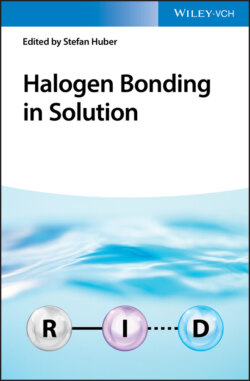Читать книгу Halogen Bonding in Solution - Группа авторов - Страница 24
1.3.4 Alternative Motifs and Solid‐state Reactivity
ОглавлениеThe use of alternative or less common designs in halogen bonding has been reviewed [104]. Some of the less common donors include N‐iodoimides (Figure 1.11a), which have been shown to be powerful halogen donors for a diverse range of acceptors [106-109]. In one example, Fourmigué and coworkers demonstrate that altering the donor and acceptor of these N‐iodoimides can be used to demonstrate the cocrystal to salt continuum, a topic generally reserved for proton transfer between a hydrogen bond donor and acceptor. In the context of halogen bonding, it is iodine transfer that results in a salt (Figure 1.11b) [105] and has also been the subject of a charge density analysis study [109]. Another alternative halogen bond is the three‐center‐four‐electron halogen bond of the type [NIN]+. These unique motifs are often compared with the low barrier hydrogen bonds of the type [NHN]+ and are the subject of an ensuing chapter.
Halogen bonds have also been used to mediate crystalline state reactivity. The first example of a photomediated [2 + 2] olefin cycloaddition was presented by Metrangolo and coworkers [110]. Here, a tetratopic halogen bond donor arranged trans‐1,2‐bis(4‐pyridyl)ethene for cycloaddition using CI⋯N halogen bonds (Figure 1.12, top). Similar tactics by Sinnwell and MacGillivray highlighted the use of a ditopic halogen bond acceptor to arrange the olefin‐containing halogen bond donors, diiodooctafluorostilbene (Figure 1.12, bottom) [112]. Once again, CI⋯N halogen bonds were employed to properly arrange the reactants. Only recently has a halogen bond cocrystal mediated a single‐crystal‐to‐single‐crystal transformation of an olefin cycloaddition [111]. The halogen bond has also been used to arrange polyacetylenes for polymerization. For example, the cocrystallization of 1,4‐diiodo‐1,3‐butadiyne with either dipyridine or dinitrile oxalamide derivatives produced 2D networks driven by both hydrogen bond and halogen bonds [113] (Figure 1.13). The pyridine derivative only polymerized when subjugated to higher pressures, whereas the nitrile derivative polymerizes spontaneously at room temperature (Figure 1.13). Solid‐state reactivity can also occur by mechanochemistry or solvent‐assisted grinding. For example, halogen bond‐mediated cocrystals were produced with mechanochemistry using 1,4‐diiodotetrafluorobenzene and 1,4‐dibromotetrafluorobenzene halogen bond donors and analyzed through powder diffraction and single‐crystal analysis [114].
Figure 1.12 Examples of halogen bond mediated [2 + 2] photodimerization of olefins in the solid state.
Source: From Sinnwell et al. [111]. Licensed under CC BY 2.0.
